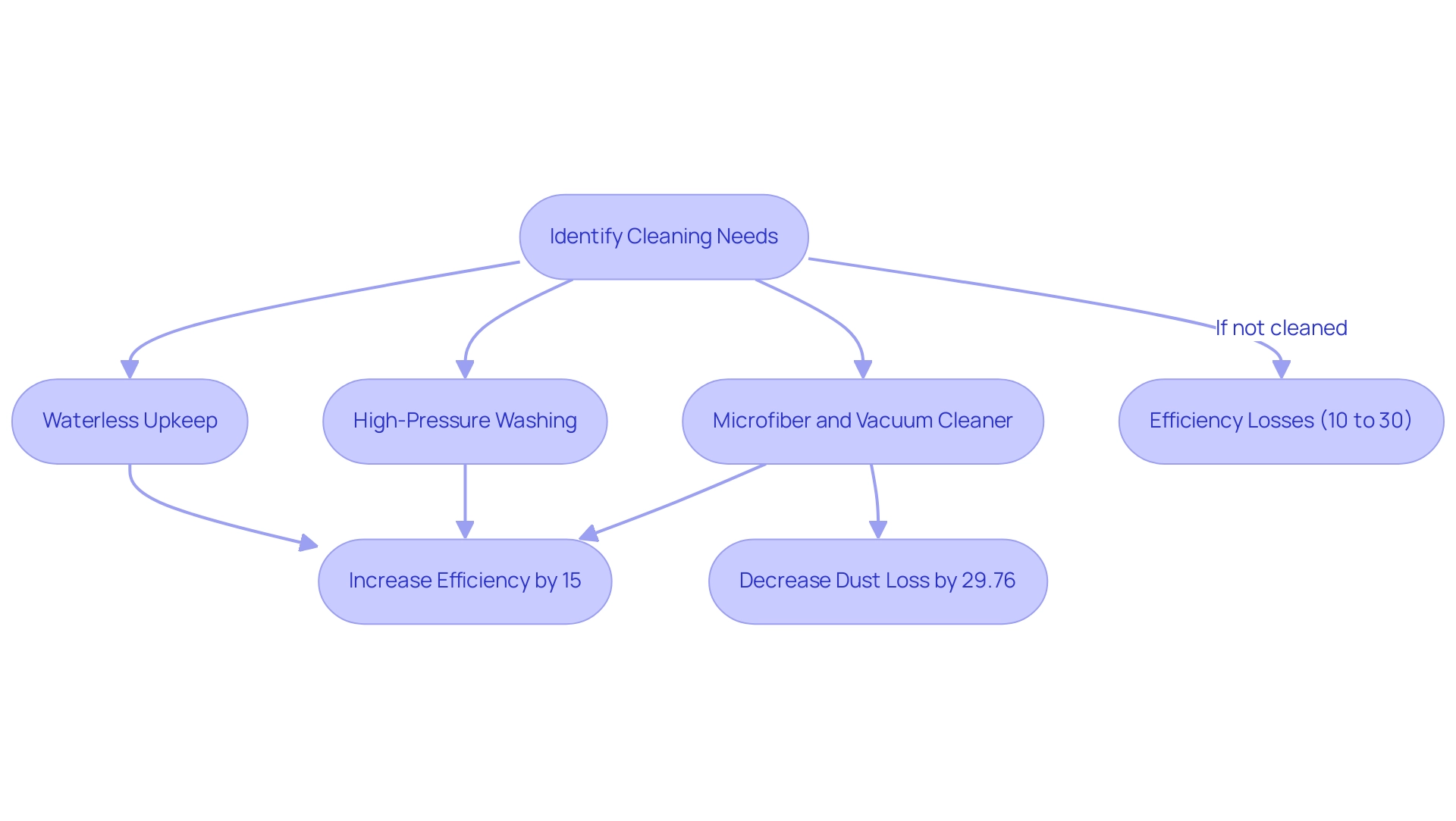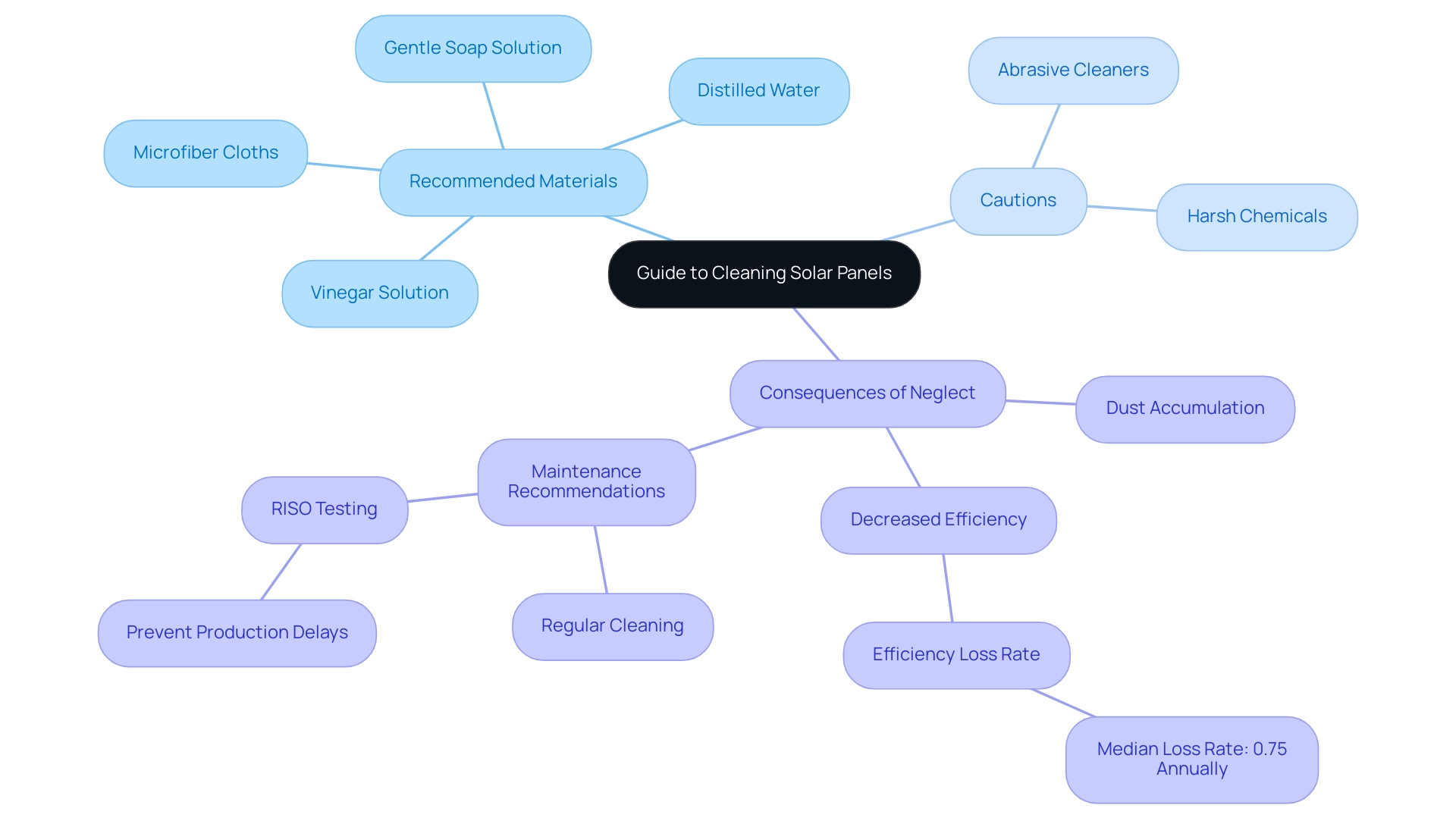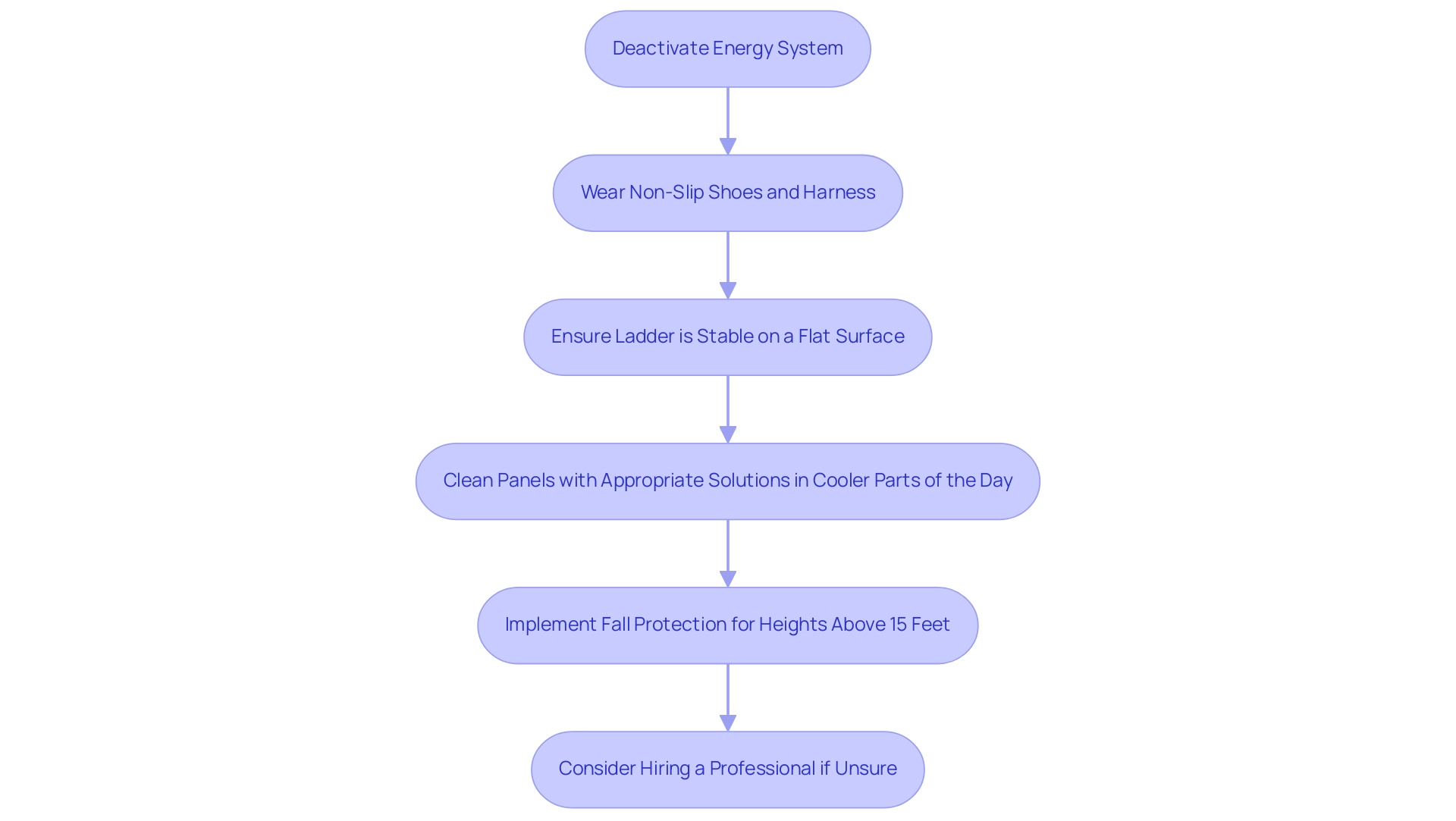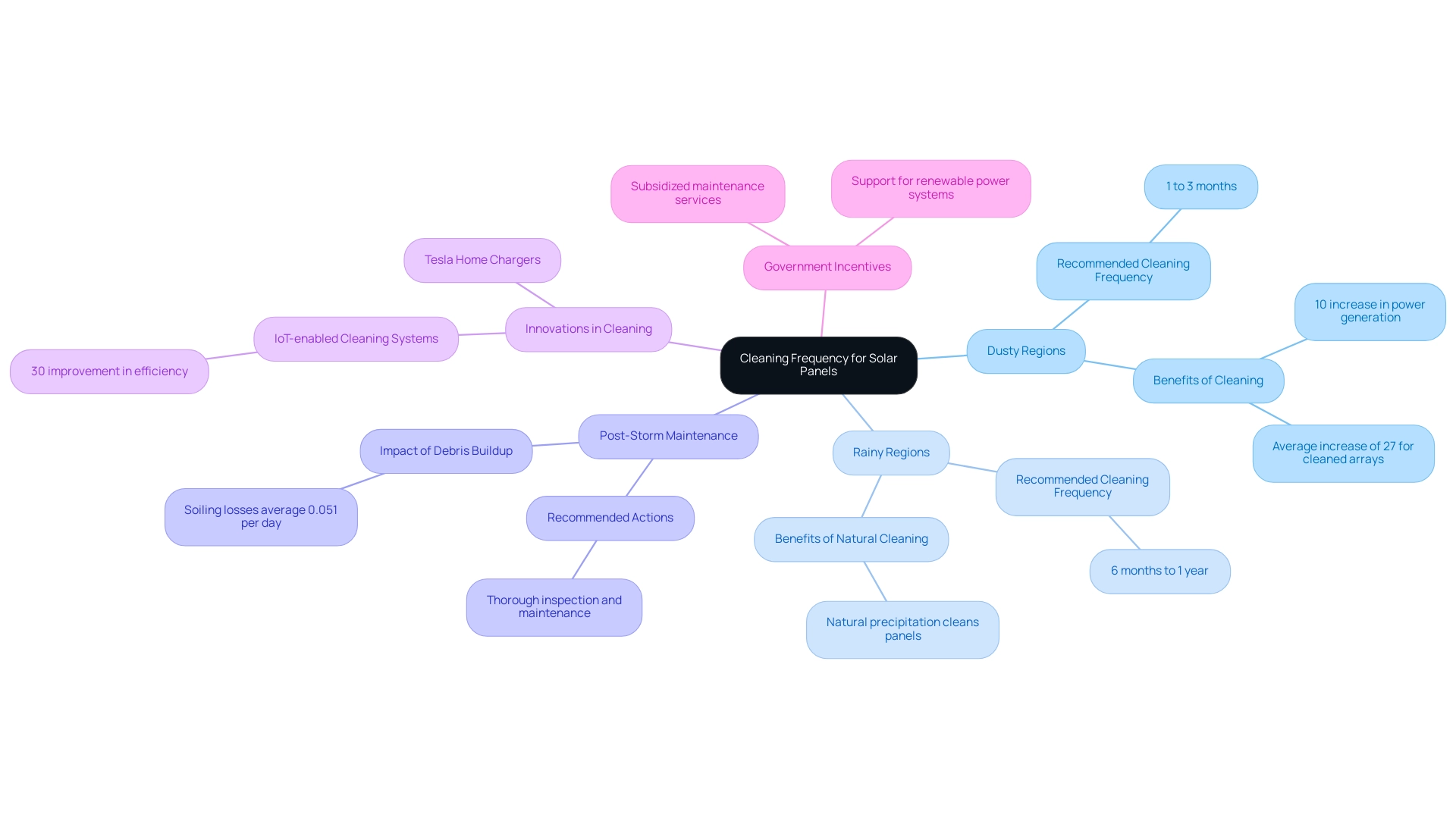Overview
The article addresses the question of what materials to use for cleaning solar panels, emphasizing the importance of using non-abrasive, gentle cleaning solutions to maintain their efficiency and longevity. It supports this by outlining effective cleaning techniques, recommending materials like microfiber cloths and distilled water, and providing evidence that proper maintenance can significantly enhance energy output and prevent efficiency losses due to dirt and debris.
Introduction
In an age where renewable energy is gaining momentum, the significance of maintaining solar panels cannot be overstated. Clean solar panels are crucial for maximizing energy production, as even minor accumulations of dust and debris can lead to efficiency losses of up to 30%.
This article delves into the essential practices for ensuring solar panels operate at peak performance, including:
- The importance of regular cleaning
- The selection of appropriate cleaning materials and techniques
It also highlights:
- Innovative technologies
- Professional services that can simplify the maintenance process
Ultimately, these practices support homeowners in their pursuit of sustainable energy solutions. By understanding the best practices for solar panel upkeep, individuals can enhance their energy savings and contribute to a greener future.
The Importance of Regular Solar Panel Cleaning
To attain maximum power generation, it is essential to know what to clean solar panels with to maintain the cleanliness of solar surfaces. To prevent significant decreases in power output, it’s important to know what to clean solar panels with, as the build-up of dust, bird droppings, leaves, and other debris can block sunlight. Research indicates that unclean surfaces can experience efficiency losses ranging from 10% to 30%.
For instance, a study conducted in Kathmandu revealed that dust accumulation over a five-month period resulted in a staggering productivity decline of approximately 29.76%. This highlights the harmful impact of urban dust on energy generation from the sun. In a first-of-its-kind study, Firat et al. utilized 3D printer technology to eliminate dust buildup from photovoltaic surfaces under laboratory conditions, achieving an impressive 15% increase in power output. Furthermore, their research demonstrated that using a microfiber and vacuum cleaner combination produced performance gains of 7.7% over a control PV surface.
In areas such as California, where renewable energy is widely embraced by eco-conscious homeowners, understanding what to clean solar panels with is essential not only for maximizing energy savings but also for prolonging the lifespan of the energy system.
To support this, professional maintenance services, such as Sunshine Cleaners and Solar Shine, offer tailored packages that include eco-friendly methods like waterless upkeep and high-pressure washing, as well as guidance on what to clean solar panels with, designed to enhance efficiency without harming the environment. Additionally, routine cleaning can mitigate the risk of long-term damage from corrosive substances, thereby enhancing the reliability and performance of the installation over time. Innovative technologies such as Automated Cleaning Robots and Self-Cleaning Coatings are also emerging, further enhancing the efficiency and sustainability of energy system maintenance.
Moreover, government initiatives promoting renewable energy can provide additional support for homeowners looking to optimize their energy systems.
Choosing the Right Cleaning Materials for Solar Panels
It is essential to know what to clean solar panels with to guarantee their durability and effectiveness. It is crucial to steer clear of abrasive cleaners or tools that may scratch the delicate surface. Instead, choose soft microfiber cloths or sponges combined with a gentle soap solution or specialized solar surface cleaners, which are what to clean solar panels with for optimal performance.
Utilizing distilled water is highly recommended, as it helps avoid the mineral deposits often left by tap water, which can impair efficiency over time. For those particularly stubborn stains, a simple mixture of vinegar and water can serve as an effective solution without compromising the integrity of the surfaces. Importantly, when determining what to clean solar panels with, avoid the use of harsh chemicals or solvents, as they can not only damage the surfaces but also potentially void any existing warranties.
As stated by an expert, “Did you notice a significant drop in power production? This issue can arise from several factors, with the most common being dust and debris accumulation. Research indicates that drones employed for cleaning can enhance energy efficiency by 3.40% to 69.40%, emphasizing the substantial advantages of effective cleaning techniques.
Moreover, keeping the surfaces clean is crucial, as dirt buildup can obstruct sunlight and result in decreased power generation, with data showing a median loss rate for photovoltaic system performance of 0.75% annually. RISO testing reveals that soiling can cause test failures, leading to production delays if the system must wait for drying conditions. This underscores the importance of regular maintenance to prevent unnecessary failures during startup, ensuring better annual production.
Furthermore, scientists from the Indian Institute of Engineering Science and Technology have created a model to estimate dust buildup on energy collectors, which can guide maintenance timelines. By adhering to these best practices, homeowners can guarantee their photovoltaic systems remain in excellent shape, ultimately boosting power generation and aiding their objective of a more sustainable and eco-friendly home. As the photovoltaic system maintenance market is anticipated to expand at a CAGR of 11%, it indicates an increasing awareness among environmentally aware homeowners of the essential role efficient upkeep methods play in optimizing renewable power solutions.
Effective Techniques for Cleaning Solar Panels
To clean solar surfaces effectively and ensure optimal energy production, it is essential to understand what to clean solar panels with, adopting a systematic approach that prioritizes both safety and efficiency. Start by evaluating the state of your surfaces to decide if maintenance is required. Common debris that can accumulate includes:
- Dust
- Dirt
- Bird droppings
These can obstruct sunlight and decrease efficiency.
If tidying is needed, start by rinsing the panels with water to dislodge any loose debris. Next, use a soft brush or sponge along with a suitable detergent, which is important to know what to clean solar panels with, to gently scrub the surface, working from the top down to prevent streaking. After scrubbing, rinse thoroughly with clean water to remove any remaining residue.
For homeowners uncomfortable with heights or lacking the time, enlisting a professional maintenance service can be a wise choice. These services, which may encompass:
- Manual upkeep
- Robotic assistance
- Specialized chemical treatments
focus on maintenance of photovoltaic installations and ensure safe and effective care. Recent insights suggest that routinely planned maintenance can considerably improve photovoltaic system efficiency; for example, the Resola robot has demonstrated an increase in energy output by roughly 4.5% over a three-month period.
This statistic underscores the value of maintaining your solar panels to maximize their performance and longevity. Furthermore, employing Multi-Criteria Decision Analysis (MCDA) can assist homeowners in evaluating and selecting the most suitable methods for maintenance, including what to clean solar panels with, based on efficiency, cost, and environmental impact. Expert Ahmed Rachid emphasizes the critical nature of selecting the appropriate method for optimal performance.
Furthermore, the Asia-Pacific photovoltaic module maintenance market is anticipated to expand, particularly in areas with significant renewable energy production potential, highlighting the necessity of efficient maintenance methods in climates conducive to energy generation.
Safety Tips for Cleaning Solar Panels
Ensuring safety during solar array maintenance is essential, particularly when working on roofs. Experts recommend wearing non-slip shoes and utilizing a harness for work at heights to minimize the risk of falls. It’s crucial to know what to clean solar panels with during cooler parts of the day to prevent the solution from drying too rapidly, which can compromise effectiveness.
Stability is key; ensure the ladder is placed on a flat surface and securely positioned to prevent accidents. According to safety guidelines, for any work performed 15 feet (4.6 m) or more from the roof edge, appropriate fall protection must be implemented, highlighting the importance of adhering to these regulations for safe practices. If there are uncertainties about conducting the task safely, hiring a professional service is a prudent alternative.
Before starting any sanitation process, always deactivate the energy system to reduce electrical risks. As Ahmed Rachid points out,
This article showcases current maintenance methods and technologies, focusing on aspects such as facility size, location, cost, and available resources, highlighting the necessity for comprehensive preparation and attention in upkeep.
Furthermore, a case study on drone-assisted photovoltaic surface maintenance showcases inventive techniques that not only improve efficiency but also emphasize safety by minimizing the requirement for workers to be on the roof.
This approach generates downward airflow to displace dust and contaminants, showcasing how modern technology can contribute to safer maintenance practices.
How Often Should You Clean Your Solar Panels?
The frequency at which solar installations should be cleaned is significantly influenced by environmental conditions, particularly for eco-conscious homeowners who are mindful of optimizing their solar energy systems. For those in regions susceptible to significant dust, pollen, or bird activity, a maintenance schedule of every 1 to 3 months is advisable to maintain optimal efficiency. Conversely, regions that experience regular rainfall may find that natural precipitation adequately cleans the panels, allowing for maintenance every 6 months to a year.
Monitoring energy output is essential; a significant decline in performance can suggest that maintenance is required. For instance, hmspain shared an experience where a simple tidying led to a surprising 10% increase in power generation, illustrating the tangible benefits of maintenance. Moreover, studies show that the average increase in power for cleaned arrays is around 27%, further emphasizing the importance of regular upkeep.
Following extreme weather occurrences or in periods marked by significant debris buildup, a thorough inspection and maintenance are prudent. Recent findings indicate that soiling losses average approximately 0.051% per day across various residential and commercial PV sites in California, underscoring the impact of environmental factors on maintenance frequency. Furthermore, property owners can benefit from governmental initiatives that offer incentives for maintaining renewable power systems, including maintenance services that are frequently subsidized or available at a reduced rate.
With the emergence of innovations like Tesla home chargers and IoT-enabled cleaning systems that can automate the maintenance of photovoltaic surfaces, homeowners can greatly enhance the effectiveness of their energy systems, with some setups demonstrating a 30% improvement. This proactive method not only guarantees optimal performance but also emphasizes the importance of knowing what to clean solar panels with to prolong the lifespan of photovoltaic systems. Furthermore, integrating battery storage solutions can enhance energy management, allowing homeowners to store excess energy generated during peak sunlight hours for later use, further optimizing their solar energy systems.
Conclusion
Maintaining solar panels is an essential practice that directly influences energy production and efficiency. Regular cleaning is crucial, as even small amounts of dust and debris can lead to significant losses in energy output, with studies showing declines of up to 30%. By utilizing appropriate cleaning materials and techniques, homeowners can ensure their solar panels remain in optimal condition, thus prolonging the lifespan of their systems and maximizing energy savings.
The selection of effective cleaning methods, whether through manual efforts or innovative technologies such as automated cleaning robots, can make a substantial difference in performance. Safety during the cleaning process is also paramount, especially when working at heights, necessitating the use of proper equipment and precautions. For those who may feel uncomfortable performing maintenance themselves, professional cleaning services provide a reliable alternative that guarantees safety and effectiveness.
Ultimately, the commitment to regular maintenance not only enhances energy production but also contributes to the overall sustainability of solar energy solutions. By adopting a proactive approach to solar panel upkeep, homeowners not only improve their energy efficiency but also support the broader goal of fostering a greener future. With advancements in technology and growing awareness of best practices, the path to optimizing solar energy systems has never been clearer.







